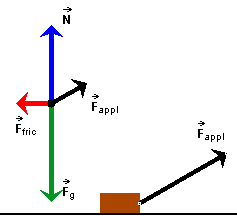
Figure 1
Friction is a component of the contact force between two objects that are touching. The component of the contact force perpendicular to the surface of contact is called normal force. The component of the contact force in the surface of contact is called friction. Friction is discussed here in the context of a block on a table surface, as illustrated in Figures 1 and 2 below.
Friction is a complicated phenomenon related to surface irregularities between the two objects in contact. When the block is sliding across the table, surface irregularities protruding both at the top of the table and at the bottom of the block and in contact with each other get deformed briefly until breaking apart again. When the block is at rest while being pulled to one side, the surface irregularities again are being deformed. These deformations are responsible for the friction forces that the table exerts on the block and the block exerts on the table. When block and table are moving relative to each other, one speaks of kinetic friction forces. When block and table are at rest relative to each other, one speaks of static friction forces.
Kinetic Friction

Figure 1
The friction force that the table exerts on the block and the friction force that the block exerts on the table form an action-reaction pair of forces. According to Newton's Third Law, they are equal in magnitude and opposite in direction. The direction of a kinetic friction force is always such that it opposes the motion. In the image above, the block is moving to the right, so that the friction force acting on the block is to the left, as indicated by the red arrow in the free-body diagram for the block in Figure 1. No free-body diagram for the table is shown, and so the friction force acting on the table is not represented. In the present case, its direction is to the right.
In reality, the magnitude of the force of friction depends on the speed with which the block is moving and it depends non-linearly on the magnitude of the normal force exerted by the table on the block. However, the following simplified model of friction is widely used and is used also in all MAP materials. In this model, the magnitude Ffric,kin of the force of kinetic friction is assumed to be proportional to the magnitude N of the normal force exerted by the table on the block, so that
Ffric,kin = mk N. ![]() (1)
(1)
The proportionality factor mk is assumed to be independent of the velocity of the block. It is called kinetic coefficient of friction.
Static Friction
Static friction has its causes in the same kind of mechanism as kinetic friction, but static friction is different from kinetic friction in one important respect.
The following image shows the block at rest while an applied force is acting on it. The block is not moving because a static friction force is acting on the block whose horizontal component is opposite in direction and equal in magnitude to the horizontal component of the applied force. Compare the magnitudes of the horizontal components of these two forces in the free-body diagram for the block in Figure 2 below. You may want to have another look at the free-body diagram in Figure 1 in which these magnitudes are unequal.

Figure 2
The magnitude of the force of static friction acting on the block does not have a fixed value, as does the magnitude of the force of kinetic friction, but adjusts itself in response to the other forces acting on the block so that the net force acting on the block remains zero, up to a certain point. The magnitude of the force of static friction cannot exceed a certain maximum, which depends on the nature of the irregularities in the contacting surfaces of block and table and on the magnitude of the normal force that table and block is exerting on each other.
In analogy to the simplistic model of kinetic friction expressed by Eq.(1), the maximum magnitude of the force of static friction is assumed to be given by the equation
Fstat,max = ms N. ![]() (2)
(2)
The proportionality constant ms is called static coefficient of friction.
Another way of formulating the content of Eq.(2) is via the inequality
Fstat  ms
N.
ms
N. ![]() (3)
(3)
Note that in Inequality (3) we have on the left-hand side the magnitude of the friction force, not the maximum magnitude as in Eq.(2).
It is usually the case that ms > mk for most objects in contact.
The direction of the force of static friction acting on an object is such that it opposes the object's tendency to move in response to other forces acting on the object.